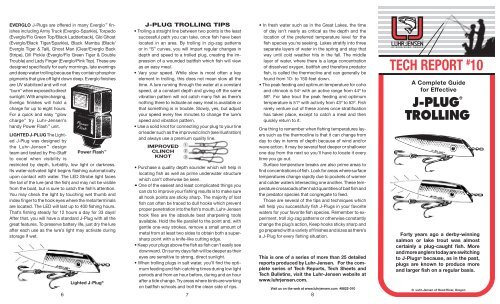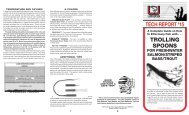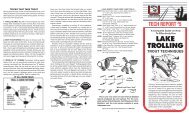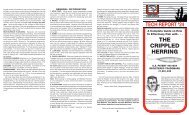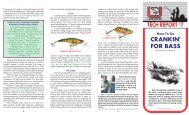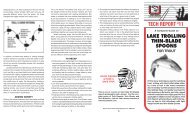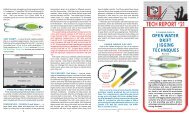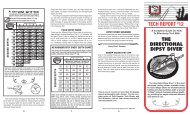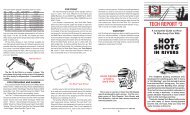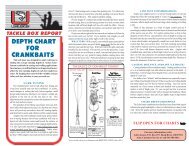J-Plug Trolling - Let's Catch Fish
J-Plug Trolling - Let's Catch Fish
J-Plug Trolling - Let's Catch Fish
You also want an ePaper? Increase the reach of your titles
YUMPU automatically turns print PDFs into web optimized ePapers that Google loves.
EVERGLO J-<strong>Plug</strong>s are offered in many Everglo finishes<br />
including Army Truck (Everglo-Sparkle), Torpedo<br />
(Everglo/Flo Green Top/Black Ladderback), Glo Ghost<br />
(Everglo/Black Tiger/Sparkle), Black Mamba (Black/<br />
Everglo Tiger & Tail), Ghost Man (Clear/Everglo Back<br />
Stripe), Dill Pickle (Everglo/Flo Green Tiger & Double<br />
Trouble) and Lady Finger (Everglo/Pink Top). These are<br />
designed specifically for early mornings, late evenings<br />
and deep water trolling because they contain phosphor<br />
pigments that give off light down deep. Everglo finishes<br />
are UV stabilized and will not<br />
“burn” when exposed to direct<br />
sunlight. With ample charging,<br />
Everlgo finishes will hold a<br />
charge for up to eight hours.<br />
For a quick and easy “glow<br />
charge” try Luhr-Jensen’s<br />
handy Power Flash unit.<br />
LIGHTED J-PLUG The Lighted<br />
J-<strong>Plug</strong> was designed by<br />
the Luhr-Jensen design<br />
team and tested by Pro-Staff Power Flash <br />
to excel when visibility is<br />
restricted by depth, turbidity, low light or darkness.<br />
Its water-activated light begins flashing automatically<br />
upon contact with water. The LED Strobe light faces<br />
the tail of the lure (and the fish) and may not be visible<br />
from the boat, but is sure to catch the fish’s attention.<br />
You may check the light by touching wet thumb and<br />
index finger to the hook eyes where the metal terminals<br />
are located. The LED will last up to 400 fishing hours.<br />
That’s fishing steady for 12 hours a day for 33 days!<br />
After that, you will have a standard J-<strong>Plug</strong> with all the<br />
great features. To preserve battery life, just dry the lure<br />
after each use as the lure’s light may activate during<br />
storage if wet.<br />
6<br />
J-PLUG TROLLING TIPS<br />
• <strong>Trolling</strong> a straight line between two points is the least<br />
successful path you can take, once fish have been<br />
located in an area. By trolling in zig-zag patterns<br />
or in “S” curves, you will impart regular changes in<br />
depth and speed to a trolled plug, creating the impression<br />
of a wounded baitfish which fish will view<br />
as an easy meal.<br />
• Vary your speed. While slow is most often a key<br />
element in trolling, this does not mean slow all the<br />
time. A lure running through the water at a constant<br />
speed, at a constant depth and giving off the same<br />
vibration pattern will not catch many fish as there’s<br />
nothing there to indicate an easy meal is available or<br />
that something is in trouble. Slowly, yes, but adjust<br />
your speed every few minutes to change the lure’s<br />
speed and vibration pattern.<br />
• Use a solid knot for connecting your plug to your line<br />
or leader such as the improved clinch (see illustration)<br />
and always use a premium quality line.<br />
IMPROVED<br />
CLINCH<br />
KNOT<br />
• Purchase a quality depth sounder which will help in<br />
locating fish as well as prime underwater structure<br />
which can’t otherwise be seen.<br />
• One of the easiest and least complicated things you<br />
can do to improve your fishing results is to make sure<br />
all hook points are sticky sharp. The majority of lost<br />
fish can often be traced to dull hooks which prevent<br />
proper penetration into the fish’s mouth. Luhr-Jensen<br />
hook files are the absolute best sharpening tools<br />
available. Hold the file parallel to the point and, with<br />
gentle one-way strokes, remove a small amount of<br />
metal from at least two sides to obtain both a supersharp<br />
point with a knife-like cutting edge.<br />
• Keep your plugs above the fish as fish can’t easily see<br />
downward. On sunny days fish will be deeper as their<br />
eyes are sensitive to strong, direct sunlight.<br />
• When trolling plugs in salt water, you’ll find the optimum<br />
feeding and fish-catching times during low light<br />
periods and from an hour before, during and an hour<br />
• In fresh water such as in the Great Lakes, the time<br />
of day isn’t nearly as critical as the depth and the<br />
location of the preferred temperature level for the<br />
fish species you're seeking. Lakes stratify into three<br />
separate layers of water in the spring and stay that<br />
way until cold weather hits in the fall. The middle<br />
layer of water, where there is a large concentration<br />
of dissolved oxygen, baitfish and therefore predator<br />
fish, is called the thermocline and can generally be<br />
found from 10- to 150-feet down.<br />
• The peak feeding and optimum temperature for coho<br />
and chinook is 54 o with an active range from 44º to<br />
58º. For lake trout the peak feeding and optimum<br />
temperature is 51º with activity from 43º to 53 º. <strong>Fish</strong><br />
rarely venture out of these zones once stratification<br />
has taken place, except to catch a meal and then<br />
quickly return to it.<br />
One thing to remember when fishing temperatures layers<br />
such as the thermocline is that it can change from<br />
day to day in terms of depth because of wind and/or<br />
wave action. It may be several feet deeper or shallower<br />
one day from the next so you'll have to locate it every<br />
time you go out.<br />
Surface temperature breaks are also prime areas to<br />
find concentrations of fish. Look for areas where surface<br />
temperatures change rapidly due to pockets of warmer<br />
and colder waters intersecting one another. These temperature<br />
crossroads often hold quantities of bait fish and<br />
the predator species that congregate to feed.<br />
Those are several of the tips and techniques which<br />
will help you successfully fish J-<strong>Plug</strong>s in your favorite<br />
waters for your favorite fish species. Remember to experiment,<br />
troll zig-zag patterns or otherwise constantly<br />
change the plug’s action, Keep hooks sticky sharp and<br />
go prepared with a variety of finishes and sizes as there’s<br />
a J-<strong>Plug</strong> for every fishing situation.<br />
This is one of a series of more than 25 detailed<br />
reports produced by Luhr-Jensen. For the complete<br />
series of Tech Reports, Tech Sheets and<br />
Tech Bulletins, visit the Luhr-Jensen website at<br />
www.luhrjensen.com.<br />
Lighted J-<strong>Plug</strong><br />
after a tide change. Try areas where birds are working<br />
®<br />
on baitfish schools and troll the clean side of rips.<br />
Visit us on the web at www.luhrjensen.com #8822-010<br />
7 8<br />
TECH REPORT # 10<br />
A Complete Guide<br />
for Effective<br />
J-PLUG ®<br />
TROLLING<br />
Forty years ago a derby-winning<br />
salmon or lake trout was almost<br />
certainly a plug-caught fish. More<br />
and more anglers today are switching<br />
to J-<strong>Plug</strong>s ® because, as in the past,<br />
plugs are known to produce more<br />
and larger fish on a regular basis.<br />
© Luhr-Jensen of Hood River, Oregon<br />
®<br />
10 J-<strong>Plug</strong> <strong>Trolling</strong>.indd 1 1/21/09 12:59:26 PM
Today's J-<strong>Plug</strong> ® is better-built and more effective than<br />
its predecessors as it’s made of super-strong materials<br />
and designed for maximum action and strength. Another<br />
advantage is the availability of special finishes designed<br />
specifically for deep water trolling and low light conditions<br />
such as Lighted J-<strong>Plug</strong>s ® , featuring battery-powered LED<br />
lights and special Everglo patterns which are charged<br />
with light at the surface then glow down deep. There is<br />
a J-<strong>Plug</strong> style and finish available today to fit any fishing<br />
situation, whether you’re after salmon, lake trout,<br />
stripers, brown trout or any large game fish.<br />
SUPERIOR MINNOW DESIGN<br />
J-<strong>Plug</strong>s are fast-action, darting plugs ideally suited<br />
for trolling. They are effective because they project an<br />
outstanding minnow image and action that all fish relate<br />
to in any water condition. This is a wounded minnow,<br />
fast darting action which comes from a combination<br />
of special swivel chain rigging and lure head chamber<br />
design. The precisely engineered tolerance between<br />
the rigging and head chamber allows the swivel chain<br />
to shift and reposition itself within the chamber. This<br />
repositioning constantly changes the plug's attitude<br />
and direction in the water and creates its erratic, fishcatching<br />
action.<br />
The swivel chain rigging also allows a direct rod-to-fish<br />
connection after the strike as the plug body will slide<br />
up the line, free of the chain and hook assembly and<br />
away from the fish. This eliminates any leverage against<br />
the plug body that causes many fish hooked with solid<br />
body-to-hook plugs to free themselves. Because the<br />
J-<strong>Plug</strong> is buoyant and separates from the hook assembly,<br />
it will float to the surface where it can be retrieved in<br />
the case of a line break or bottom snag.<br />
The J-<strong>Plug</strong> is fished successfully with a variety of<br />
trolling techniques. <strong>Trolling</strong> is effective, particularly<br />
on big waters, as you can cover the greatest amount<br />
of water in the shortest time, allowing you to locate<br />
concentrations of fish quickly and easily. Following are<br />
recommended J-<strong>Plug</strong> trolling techniques.<br />
FLATLINE With the surface or flatline technique, the<br />
plug is tied directly to 12- to 20-lb. test main line. No<br />
additional weights are used or, at most, a small 1/8- to<br />
1/2-oz. keel-type sinker is added six feet up the line<br />
from the plug. The lure is let out behind your moving<br />
boat 50- to 100-feet and the troll began.<br />
SURFACE (FLATLINE)<br />
NOTE Anglers fishing for lake trout or brown trout sometimes<br />
let out at least 200 feet of line (and as much as<br />
500- to 600-feet) as these fish can be very skittish of<br />
the boat wake. This technique is most effective when<br />
stripers, lake trout, salmon or brown trout are feeding<br />
just subsurface or when there’s an abundance of visible<br />
surface activity.<br />
SHALLOW/MEDIUM Incorporating keel sinkers of 1- to<br />
8-ounces, shallow to medium depths can be effectively<br />
targeted. Place the selected keel sinker 4- to 6-feet in<br />
front of the J-<strong>Plug</strong> and as in flatlining, let out 50 to 100<br />
feet of line behind your moving boat and begin the troll.<br />
Recommended main lines for this application are 12- to<br />
30-pound, depending on the size of weight used and<br />
depth desired.<br />
NOTE Always attach a swivel chain-rigged keel sinker<br />
with the single swivel end knotted to your main line and<br />
the swivel chain end back to the plug.<br />
KEEL SINKER<br />
DIVERS One effective way to get a plug deep without<br />
excessive lead weights or the use of a downrigger is<br />
with a diving planer such as the Deep Six , Double Deep<br />
Six , Pink Lady or directional Dipsy Diver ® . Standard<br />
rigging is with 4- to 6-feet of leader between plug and<br />
diver and 20- to 30-lb. test main line to your rod.<br />
Set the diver to the diving position, or in the case of<br />
the directional Dipsy ® set both the depth and side angle<br />
desired, with your boat moving, let out roughly 2 feet<br />
of line for every foot of depth desired (slowly to ensure<br />
that no tangles occur) and begin the troll.<br />
PINK LADY / DIPSY DIVER<br />
DIVER & DODGER<br />
DOWNRIGGERS The most popular way to fish J-<strong>Plug</strong>s<br />
are off a downrigger, by themselves. With a downrigger<br />
you will be able to work all depths and will have the<br />
advantage of no weight between you and a hooked<br />
fish. Anglers who troll J-<strong>Plug</strong>s by themselves behind a<br />
downrigger often prefer 10 to 20 feet (some as much as<br />
40 feet) between the line release and plug. The longer<br />
lengths add to the erratic, darting action of the plug.<br />
Dodgers can be used as attractors in conjunction<br />
DOWNRIGGER<br />
SETUPS<br />
with a #3 J-<strong>Plug</strong> behind a downrigger with good results.<br />
Size 0 or Size 1 Jensen Dodgers are recommended.<br />
Be sure to allow at least six feet of line between the<br />
dodger and downrigger line release so as not to inhibit<br />
the dodger’s action. Allow 20 to 30 inches of leader<br />
between the J-<strong>Plug</strong> and dodger (shorter leaders impart<br />
faster plug action and longer leaders, slower action).<br />
LARGE PLUGS / LARGE FISH<br />
Larger fish do prefer large plugs. Big fish will spend<br />
the least amount of energy necessary to catch a meal,<br />
so larger baitfish mean less energy is expended to fill<br />
up. Hence, if you’re after trophy salmon, lake trout or<br />
stripers use the larger size 5 J-<strong>Plug</strong>. But, remember<br />
that smaller fish often will not attack a large plug so<br />
the use of larger plugs is a big fish technique and often<br />
precludes catching numbers of fish.<br />
Size 4 J-<strong>Plug</strong>s are incredibly popular because they<br />
appeal to a broad spectrum of fish under a wide range<br />
of conditions. They perform well with all rigging styles<br />
and fishing applications, from shallow to deep. Because<br />
of their versatility, size 4 J-<strong>Plug</strong>s are available in the<br />
broadest selection of colors.<br />
Size 3 J-<strong>Plug</strong>s are the smallest available. They offer a<br />
tactical advantage when fish are selectively targeting small<br />
bait or when extremely clear water forces you to downsize<br />
your presentation to get strikes. Size 3 J-<strong>Plug</strong>s will also<br />
produce the most active action at the slowest trolling<br />
speeds, a key feature when lethargic fish seem to want a<br />
highly active bait, but will not chase it down aggressively.<br />
The performance of all J-<strong>Plug</strong>s will be enhanced by<br />
taking just a few steps. Before placing your plug in the<br />
water, check the swivel chain dacron harness for wear<br />
and to ensure the knot is cinched tight. If the harness<br />
needs replacing they are available in tackle stores. The<br />
harness is built from 80-lb. test dacron, doubled. The<br />
hooks that come with it are high quality, 4X strong and<br />
plated to resist corrosion. When not actively fishing the<br />
lures, keep them in your tackle box. Extreme heat can<br />
deform a plug’s shape and direct sunlight can cause<br />
the finish to fade.<br />
J-PLUG FINISHES / COLORS<br />
One of the big reasons today’s J-<strong>Plug</strong>s are effective<br />
is because of the wide variety of finishes and colors<br />
available; one to fit any angling situation. Following is a<br />
rundown on some of the more popular finishes and what<br />
each represents and accomplishes in the water.<br />
METALLICS Highly reflective metallic finishes match the<br />
flash and colors of baitfish. Silver Bullet, Silver Green Top<br />
and Silver/Blue Top feature the reflective look of baitfish.<br />
Metallic finishes are most effective when ambient light is<br />
available at the fishing depth to reflect off the lures.<br />
2<br />
3 4 5<br />
10 J-<strong>Plug</strong> <strong>Trolling</strong>.indd 2 1/21/09 12:59:26 PM


